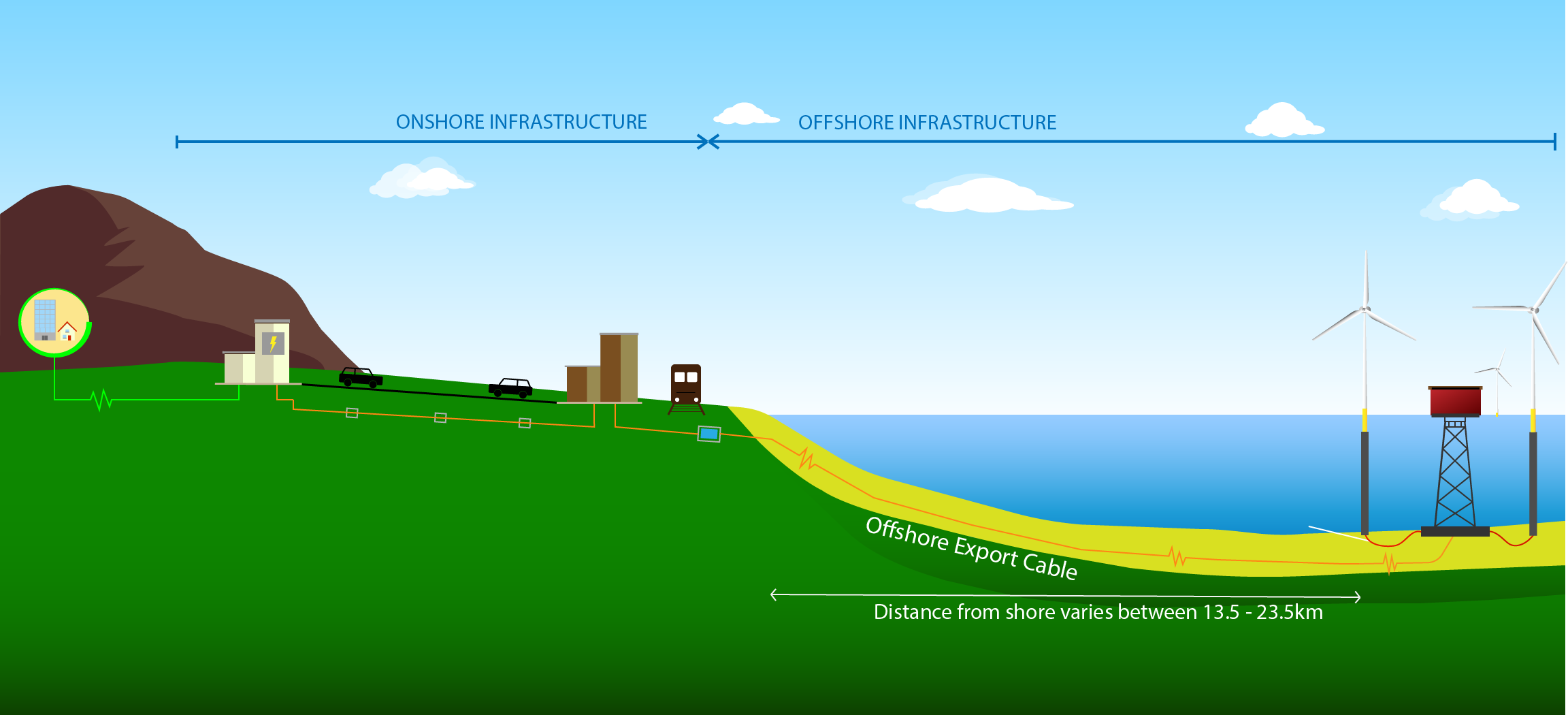The Project at a GLANCE
Current working design layout to include a maximum of 49 turbines
Produce renewable energy for Ireland's electricity grid
Will displace approximately half a million tonnes of CO2 per annum
Off the coast of Dublin, Meath and Louth
Capacity to power approx. 500,000 homes
Community Benefit Fund of approximately €4 million per annum
Potential to create high-quality jobs
Planned connection point: Belcamp Station
NISA is a Strategic Infrastructure Development which is of strategic or social importance to the local area and as such requires a direct application to An Bord Pleanála
Associated works will include turbine foundations, subsea electrical and communications cables, temporary site compounds, substations, grid systems services, underground electrical and communications cables, joint bays, grid connection and operation and maintenance facilities.
Location
The area being considered is located off the coast of Dublin, Meath and Louth. The closest potential turbine location would be approximately 13km from shore. For more information on the location, please see our Location & Visuals page.
NISA - Project Infrastructure
Offshore Design Layout
The offshore infrastructure is located within the proposed development boundary and will comprise the following:
Array area – where the following infrastructure will be located:
- Offshore Wind Turbine Generators (WTGs)
- Offshore Substation Platform (OSP)
- Seabed foundations (for WTGs and OSP)
- Inter-array cables
- Offshore Export Cable Corridor – where the offshore electrical infrastructure, consisting of two export cables, will be routed from the OSP to landfall.
Photomontages of how the project design would look can be viewed by clicking this link to our Photomontage Viewer.
Offshore Cables
Considerations of cable routing offshore include:
- Wind farm layout and landfall location
- Seabed conditions and rock outcrops
- Fishing practices in the area
- Environmental considerations including avoiding designated protected areas
- Location of marine archaeological features
- Energy efficiency considerations
Landfall location
Following a review of the coastline from Rush to Bettystown, an area north of Balbriggan has emerged as the most feasible area to bring the cables on shore.
Many factors were considered such as local appropriateness and the need to avoid disturbance to the foreshore or coastline. A decision has been taken that there will be no grid facility between the road and the coast as it would not have been visually appropriate.
Cables will come onshore under the coastline to the north of Balbriggan. While the cables will land here, their presence will be concealed due to the availability of HDD (see below for HDD technology) which removes the need to disturb the coastline.
Factors considered in this decision included available lands, fisheries, road network, existing services and geology.
Horizontal Directional Drilling (HDD)
Both open cut and trenchless drilling were considered in this project. Trenchless is the most appropriate option as feedback from our engagement process was that people would rather not see the coastline disturbed. We are confident that this methodology can be applied.
Onshore Grid Facility
A grid facility will be required in the area as part of the infrastructure needed as part of this project. A decision has been taken to not have any infrastructure between the road and the coast. Therefore, this facility will be located to the west of the road R132. This is required not only to facilitate the transmission of the electricity from the wind farm to the connection point, but it will also strengthen the electricity grid in this area.
Cable Route
The proposed cable route will go around the north of Balbriggan, follow local roads wide enough to minimise the need for closures, cross under the M1 and arrive at the grid connection point at Belcamp.
Connection at Belcamp Substation
EirGrid has specified that NISA’s grid connection point is at Belcamp Substation. Belcamp is a facility on the national grid with great connectivity and capacity.
EirGrid Functional Specifications
NISA must also be cognisant of the relevant EirGrid Specification which outlines the basis for the design of the cable route and specifies that “Underground cables shall, as a standard, be routed within the reserve of public roads.”
In addition to these points, our assessments to date have taken account of several different factors including:
- Future road upgrades
- Impacts of traffic management during construction
- Existing services
- Active Travel initiatives – possibility of creating cycle paths as part of the reinstatement works
- Environmental consideration
- Existing infrastructure
More detail on the proposed route is available on our Virtual Consultation Room.
Click on the hotspots

Offshore Wind Turbines
Offshore Substation
Inter-array cables
Transition Joint Bay
Onshore substation
DART Rail Line
Underground Cable Circuit and Joint Bays
Existing Eirgrid Substation at Belcamp
Houses & Businesses
